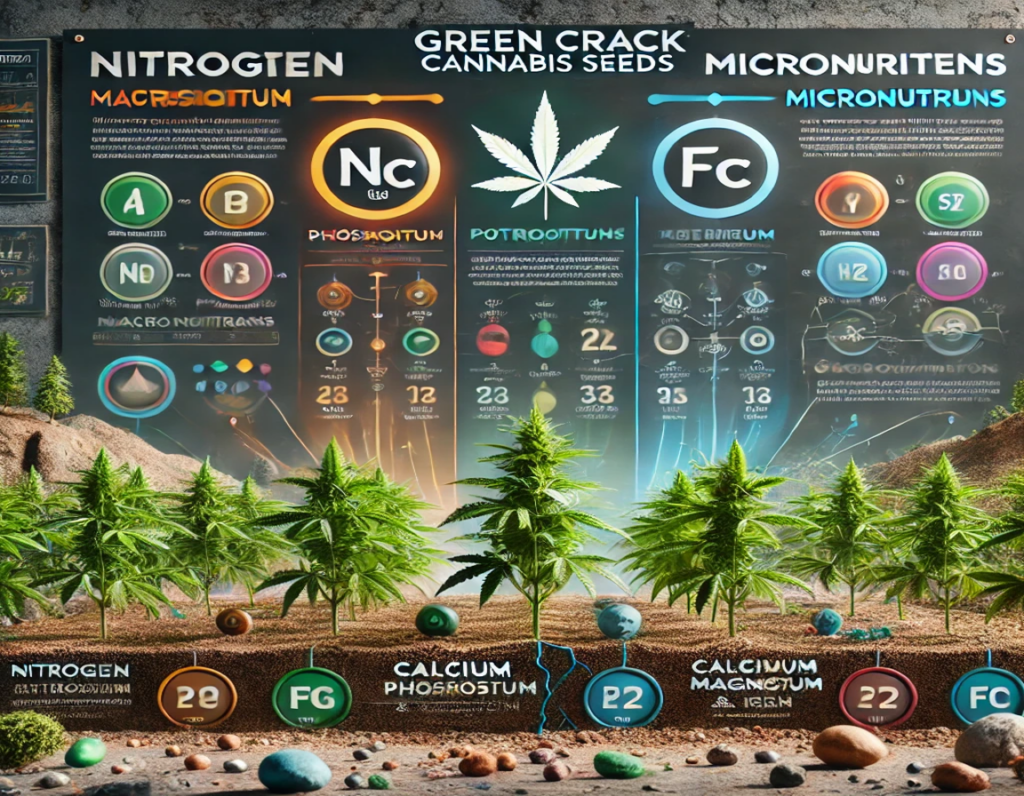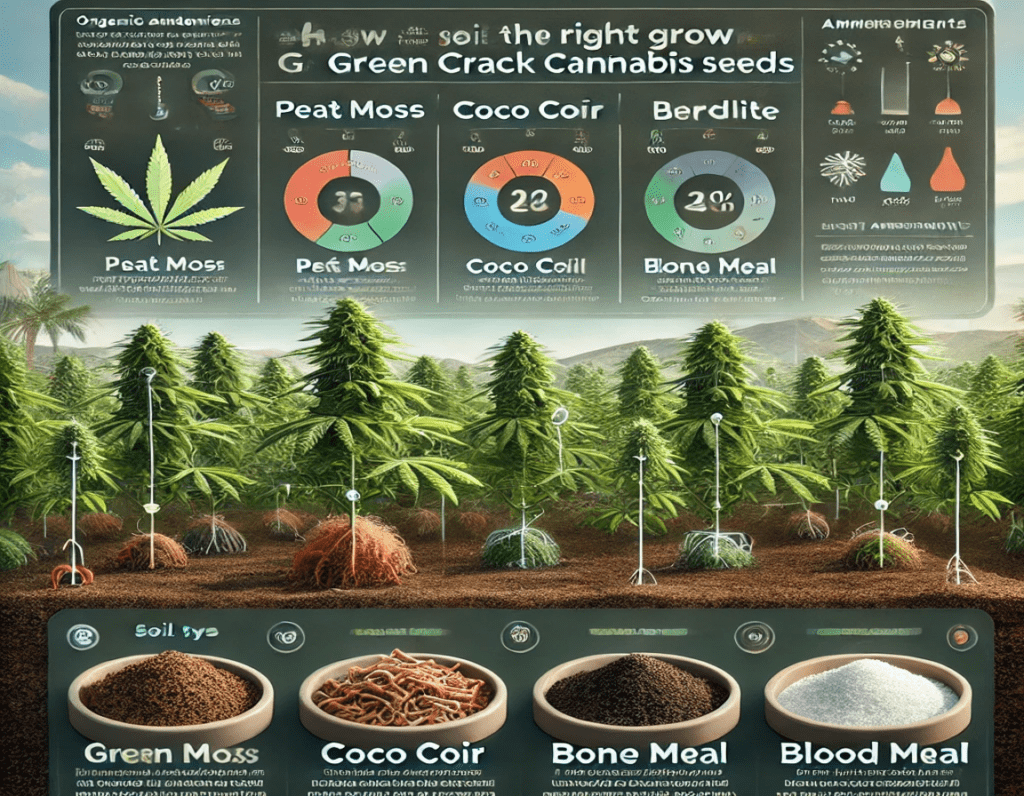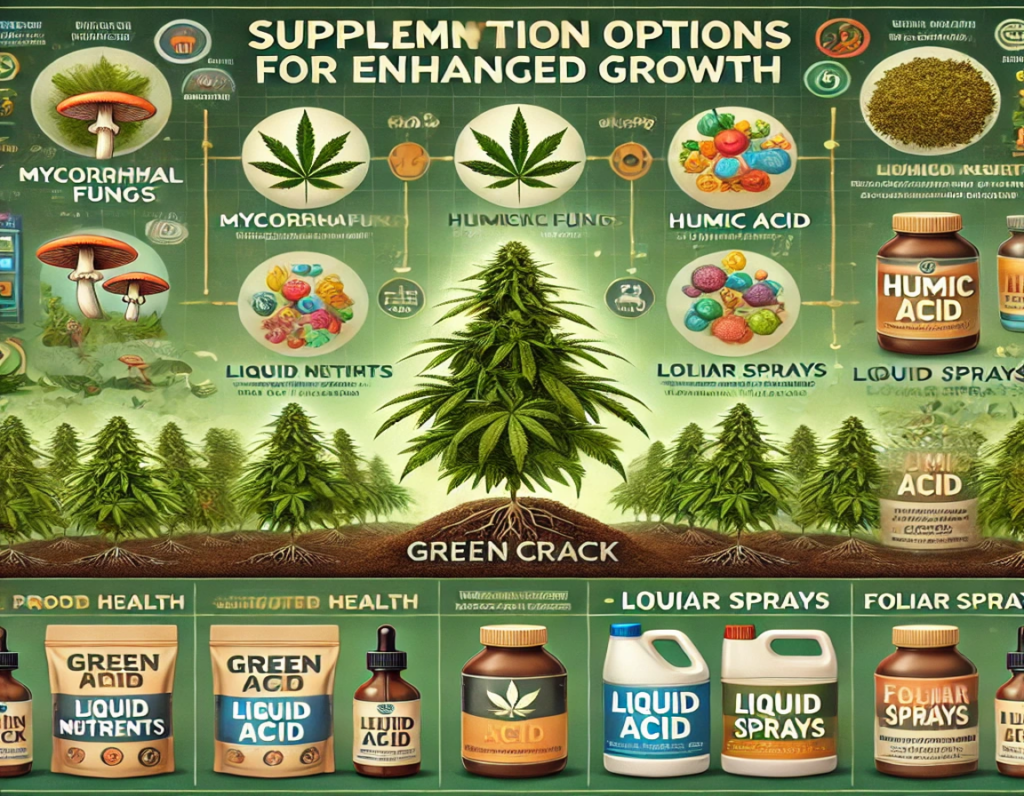
To grow healthy Green Crack cannabis plants, it’s essential to provide them with the right nutrients at each growth stage. Cannabis plants require a balanced mix of macronutrients and micronutrients to thrive and produce high-quality buds. Understanding these needs helps you tailor your fertilization and supplementation strategies for optimal growth.
Macronutrients are the primary building blocks for plant growth. The three essential macronutrients for cannabis cultivation are:
Nitrogen (N): Crucial for vegetative growth, nitrogen promotes leaf and stem development. It plays a vital role in chlorophyll production, which is essential for photosynthesis. During the vegetative stage, plants require higher nitrogen levels. If nitrogen levels are inadequate, you may notice slower growth, pale green leaves, and overall poor plant health.
Phosphorus (P): Important for root development and flower production, phosphorus supports energy transfer within the plant. It is essential during the flowering stage, helping to increase bud size and overall yield. Deficiencies in phosphorus can lead to stunted growth and reduced flower production, evident through dark green leaves that may display purple undertones.
Potassium (K): Potassium aids in overall plant health, helping to regulate water uptake and enzyme activity. It enhances disease resistance and is critical during both the vegetative and flowering stages. Low potassium levels may lead to weak stems, poor fruit development, and increased susceptibility to diseases.
While required in smaller amounts, micronutrients are equally important for the health of your plants:
Calcium (Ca): Essential for cell wall structure and stability, calcium helps prevent issues like blossom end rot and tip burn. Calcium deficiencies often result in deformed leaves and poor root structure.
Magnesium (Mg): A key component of chlorophyll, magnesium aids in photosynthesis and helps with nutrient uptake. Deficiencies in magnesium can lead to interveinal chlorosis, where the tissue between the leaf veins turns yellow.
Iron (Fe): Important for chlorophyll synthesis, iron deficiencies can lead to yellowing leaves, particularly in new growth. Ensuring your plants have access to iron is crucial, especially during rapid growth periods.

Selecting the right soil mix and amendments is crucial for providing the necessary nutrients for your Green Crack seeds. A high-quality soil mix will contain a balanced blend of nutrients and organic matter to support plant growth.
Consider using a soil mix specifically designed for cannabis cultivation, which often includes:
Peat Moss: Provides excellent moisture retention and aeration, promoting healthy root growth. It acts as a sponge, holding moisture and nutrients while allowing excess water to drain away.
Coco Coir: A sustainable alternative to peat, coco coir offers great drainage and aeration while retaining moisture. It helps maintain a stable pH level and encourages beneficial microbial activity in the soil.
Perlite or Vermiculite: These materials improve drainage and aeration, helping to prevent root rot. They create air pockets in the soil, allowing for better oxygen flow to the roots.
Incorporating organic amendments can enhance the nutrient profile of your soil. Some beneficial amendments include:
Worm Castings: Rich in nutrients and beneficial microorganisms, worm castings promote healthy root development. They improve soil structure and provide a slow-release source of nitrogen.
Bone Meal: A great source of phosphorus, bone meal supports root growth and flower development. It is particularly useful during the flowering stage when plants need extra phosphorus.
Blood Meal: High in nitrogen, blood meal can be used to boost vegetative growth. It is a fast-acting source of nitrogen that can help correct deficiencies.

Understanding the specific nutrient requirements during each growth stage will help you tailor your fertilization schedule effectively.
During the seedling stage, Green Crack plants need minimal nutrients. Too much fertilization can hinder growth and cause nutrient burn. Focus on providing a light mix of nitrogen and phosphorus to support initial growth. A nutrient solution with lower concentrations is recommended, typically in a ratio of 1-2-1 (N-P-K).
Watering Practices: Ensure the soil remains moist but not saturated. Seedlings are particularly vulnerable to overwatering, so be cautious. Water lightly, allowing the top layer of soil to dry out between waterings.
In the vegetative stage, increase nitrogen levels to support robust leaf and stem development. A balanced N-P-K ratio of around 3-1-2 is ideal. This stage is critical for establishing a strong foundation for future growth. Regularly check for signs of nutrient deficiencies, such as yellowing leaves or stunted growth.
Nutrient Schedule: Fertilize every 1-2 weeks, ensuring that you are providing balanced nutrients. Organic fertilizers can be beneficial at this stage, as they slowly release nutrients and improve soil health.
As your plants transition to the flowering stage, shift to a nutrient formula higher in phosphorus and potassium to support bud development. An N-P-K ratio of around 1-4-5 is beneficial at this stage. Monitor for any signs of deficiencies, such as yellowing leaves or poor bud development, and adjust your nutrient regimen accordingly.
Final Weeks Before Harvest: In the last few weeks leading to harvest, consider using a bloom booster or specialized flowering nutrients to maximize yield. Reduce nitrogen levels to encourage the plant to focus on flower production.

In addition to the primary nutrients, various supplements can enhance growth and improve plant health.
Mycorrhizal Fungi: These beneficial fungi enhance root development and nutrient uptake by forming symbiotic relationships with plant roots. They can improve drought resistance and overall plant vigor, making them an excellent addition to your soil mix.
Humic Acid: This organic compound aids in nutrient absorption and enhances soil structure, promoting healthier root systems. Humic acid improves the availability of nutrients to plants, helping them grow more vigorously.
Using liquid nutrients allows for precise adjustments based on your plants’ needs. Consider products specifically designed for cannabis, which provide balanced formulations for each growth stage. These liquid feeds can be mixed with water and applied during regular watering to ensure consistent nutrient delivery.
Benefits of Liquid Nutrients: They can be rapidly absorbed by plants, making them ideal for addressing deficiencies quickly. Adjusting concentrations based on plant response can lead to healthier growth.
Foliar feeding involves applying nutrients directly to the leaves, allowing for quick absorption. This method can be particularly effective for micronutrient deficiencies, as leaves can quickly absorb nutrients without going through the root system.
Application Timing: Foliar sprays should be applied during the early morning or late afternoon to avoid leaf burn from direct sunlight. Ensure that the solution is evenly distributed for maximum effectiveness.
Healthy soil is the foundation of a successful cannabis crop. Incorporating practices that enhance soil health will lead to better nutrient availability and overall plant health.
Incorporating different plant species in your growing area can improve soil health and reduce pest pressure. Rotate crops to disrupt pest cycles and enhance soil nutrients naturally.
Planting cover crops during the off-season helps prevent soil erosion, adds organic matter, and improves soil structure. They can also suppress weeds and improve biodiversity in the soil ecosystem.
Conduct soil tests at least once a year to determine nutrient levels and pH. Regular testing helps you make informed decisions about amendments and fertilization practices.
Green Crack plants require nitrogen, phosphorus, and potassium as primary macronutrients, along with calcium, magnesium, and iron as micronutrients.
The frequency of fertilization depends on the growth stage and nutrient needs. Generally, fertilizing every 1-2 weeks during the vegetative stage and every 1-3 weeks during flowering is recommended.
Yes, organic nutrients are an excellent option for growing cannabis. They promote healthy soil and can improve the overall quality of your plants.
Signs of nutrient deficiencies can include yellowing leaves, stunted growth, and poor bud development. Identifying the specific deficiency often requires observing the plant’s symptoms and researching common deficiency indicators.
Yes, maintaining the proper pH level (6.0-7.0 for soil) is essential for optimal nutrient uptake. Regularly check and adjust the pH of your water and nutrient solutions.
We ship and deliver world wide via USPS and various couriers.
We offer a wide range of secure and anonymous online payment options.
We care about you, our customer. Please contact us with any questions or concerns.
Find out more about the benefits of being a loyal and regular customer.
WE ARE EVERY GROWERS ONE STOP SHOP TO ACQUIRE PREMIUM CANNABIS SEEDS FOR SALE IN THE USA, CANADA AND AUSTRALIA

Farmers Lab Seeds 2024, | All Right Reserved
Seeds are sold as novelty items, souvenirs, and collectibles. They contain 0% THC. We encourage our customers to check the legislation in their Country, State, Province, and Municipality prior to purchasing items from our store. We do not provide growing information.
All seeds are sold as hemp, and lab tested under 0.3% THC. This product is not for use by or sale to persons under the age of 21. This product should be used only as directed on the label. It should not be used if you are pregnant or nursing. Consult with a physician before use if you have a serious medical condition or use prescription medications. A Doctor’s advice should be sought before using this and any supplemental dietary product. All trademarks and copyrights are property of their respective owners and are not affiliated with nor do they endorse this product.
These statements have not been evaluated by the FDA. This product is not intended to diagnose, treat, cure or prevent any disease. Individual weight loss results will vary. By using this site, you agree to follow the Privacy Policy and all Terms & Conditions printed on this site. Void Where Prohibited by Law.